#hypereides
Text

Phryne before the Areopagus by Jean-Léon Gérôme
#jean léon gérôme#art#phryne#areopagus#hypereides#robe#beauty#trial#impiety#acquitted#ancient greek#ancient greece#greek#greece#antiquity#classical#history#europe#european
90 notes
·
View notes
Text
When it comes to how I imagine the birth order of Hera's children, I'll admit that I'm not faithfully adhering to any ancient source, but mostly combining various accounts and adding and subtracting as necessary. In fact I think that my opinions are pretty unorthodox in this area.
To start with what some sources tell us: in Hesiod's Theogony Hera bears to Zeus Hebe, Ares and Eileithyia (listed in this order) and in the Library of Apollodoros Hebe, Eileithyia and Ares (listed in this order in all translations I've read, but I haven't looked at the Greek text to confirm). Note that the order in which these three gods are named need not be their actual birth order. In Hesiod's Theogony, for example, Styx is mentioned last on the catalogue of daughters of Okeanos, yet she is the oldest of them all. The birth of Hephaistos is set apart from those of Hera's other children in both sources, in the Theogony taking place after (and likely in reaction to) Athena's birth, in the Bibliotheke before it. However, the birth order of the younger gods obviously can differ greatly from one source to another: Apollon is the oldest son of Zeus in the Theogony, but in Homeric Hymn to Apollo Hephaistos seems to have been born before him, and in Kallimachos' Hymn to Delos both Ares and Hephaistos are older; in Hesiod's Theogony Ares is conceived after but born before Athena, in the Bibliotheke he is both conceived and born before her, but in one variant (only attested by Ovid but this doesn't have to mean that he invented it) he is conceived and born in response to her birth; in the Theogony Apollon is born before Eileithyia, but in Homeric Hymn 3 he can only be brought into the world with her help; in the Theogony Apollon is also born before Athena, but in the Bibliotheke she is born before, and in one tradition (Hypereides fragment 67) she was the one who guided the pregnant Leto to Delos.
Anyway, personally I consider Eileithyia Hera's eldest. Do I have any evidence for this? No. I could argue that my interpretation is based on the fact that this goddess is not only very old in historical terms but is also given an alternative origins as the „clever spinner”, older than Kronos in a hymn of Olen. In truth, however, this is mostly based on vibes. I imagine that she was born before Hera and Zeus were formally married, which is why she is born on earth, in a Cretan cave (Pausanias, Description of Greece 1.18.5, Nonnos, Dionysiaca 8.178 ff). Why would Hera, the lawfully wedded wife of Zeus, need to give birth to her daughter in a cave on earth? It is because Eileithyia was a Cretan goddess with a sanctuary at Amnisos (as attested on the Linear B Tablets) and who originally was independent from Hera? Yes, in all probability, but I'm trying to have fun here. Being a kourotrophic deity, I imagine that she might have taken care of her younger siblings.
Hephaistos is her second child and first son. Yes, Ares is generally considered older than Hephaistos, but Idc, there is little chronological logic in the myths of Hephaistos anyways, and he can even be conceived during Zeus and Hera's secred premarital affair in some accounts (X). I'm fond of the idea that Athena, goddess of both war and crafts, was born between the gods of war and of crafts respectively, and I'm placing Hephaistos first of this trio because I want to and because the sources where he is born before Athena are actually more numerous than those where she is born before him (X). In one account attributed to Hesiod (Hes. Fr. 343), the births of Hephaistos and Athena are linked, Zeus sleeping with Metis after Hera has Hephaistos on her own. I'm keeping this order of events, except that he is not actually a fatherless child. After his birth, which I imagine to put some strain on Zeus and Hera's marriage, Zeus sleeps with Metis (the first time he cheats on Hera in the story I'm imagining) which eventually leads to him giving birth to Athena himself.
In my mind Hephaistos is in fact the son of both Hera and Zeus (as in the Odyssey and probably in the Iliad), but doubts exist as concerns his origins. Given that he was born disabled, rumour circulates that he must not be Zeus's son (all of his other children are perfect and lovely in form, after all) and that Hera had him on her own. Zeus himself has doubts and at least in the beginning thinks that Hephaistos is not his.
Typhon, if he is Hera's son as I prefer him to be, would be born to her in revenge to Athena's birth from Zeus. She has Gaia's help in producing him, so that is why he is so different from her other children. I'm considering the idea that in conceiving Typhon Hera is not only motivated by the desire to compete with Zeus, but also might have become aware of the true circumstances of Athena's birth and realises that Zeus is willing to engage in the same kind of ruthless behaviour for which they fought and deposed their father.
Then follows Ares. During her pregnancy with him Hera finds out that Leto is also pregnant and that it is believed that she will give birth to a mighty and distinguished son. Needless to say that she is furious, both because of the infidelity, but even more because someone else is going to bear to Zeus a great son when the one Hera herself had given him was disappointing to the point that some even suspect that he was not Zeus's child at all. As a result, the last thing she wants is for Leto to give birth to Apollon before Hera proves that she is perfectly capable of bringing forth a powerful and glorious son. Ares is born before Leto's children because Hera prelongs her labour with the help of Eileithyia, but, unfortunately for her, the birth of the twins far outshines that of Ares, and Apollon does turn out to be more powerful, more respected by gods and mortals, and far more beloved by Zeus than Ares.
And Hebe, youth personified, is her youngest. I'm pretty basic here and I don't have any notable opinions about this one.
Prometheus, Angelos/Hekate, Pasithea or the Graces in general are also called her children in some sources, but, except for Prometheus who would be her very first child (born before her marriage to Zeus not that I would be likely to use this parentage for him), I have no idea about how the rest could be arranged. Eris and Enyo are sometimes called sister of Ares which could mean that Hera is their mother. I'd be more tempted to accept Eris as a daughter of Hera (even though Nyx is her mother in the Theogony) because strife is so characteristic of Hera's relationship with Zeus and of her personality in general, and we even have one story where these two goddesses actually interact. By contrast there is 0 connection between Hera and Enyo.
20 notes
·
View notes
Text
Ashley, reading to people at Thanksgiving dinner about Phryne: “She is best known for her trial for impiety, where she was defended by the orator Hypereides.--”
Everybody else in unison: HYPEREIDES NUTS!
3 notes
·
View notes
Text
Paintings by Jean-Léon Gérôme who, er, had a theme.
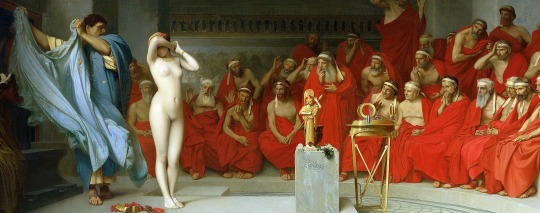

Phryne before the Areopagus (1861).
Phyrne was a courtesan put on trial for essentially having a bit too much of a good time. She was acquitted after her defender Hypereides removed her robe and exposed her naked bosom, "to excite the pity of her judges by the sight of her beauty," as Victorian poet Charlotte Yonge's English translation put it.

The Roman Slave Market (c.1884)

The Great Bath at Bursa (1885)

The Slave Market (1871).

Slave Market in Ancient Rome (c. 1884)

Pool in a Harem (c. 1876).
4 notes
·
View notes
Note
where did you find the art of your header and profile picture
Thank you for asking! They’re two of my favourite paintings. My profile picture is Lady Godiva painted by John Collier. According to Wikipedia - Lady Godiva took pity on the people of Coventry, who were suffering grievously under her husband's oppressive taxation. Lady Godiva appealed again and again to her husband, who obstinately refused to lower the taxes. At last, weary of her entreaties, he said he would grant her request if she would strip naked and ride on a horse through the streets of the town. Lady Godiva took him at his word, and after issuing a proclamation that all persons should stay indoors and shut their windows, she rode through the town, clothed only in her long hair. Just one person in the town, a tailor ever afterwards known as Peeping Tom, disobeyed her proclamation in what is the most famous instance of voyeurism.
The header is actually a painting which I own a beautiful print of - gifted to me by a dear friend who imagined me naked and stripped in the same way. It’s called Phryne before the Areopagus by Jean-Léon Gérôme, and tells the story of Phryne, a Greek courtesan who was prosecuted for impiety and defended by the orator Hypereides, who was one of her lovers. When it seemed as if the verdict would be unfavourable, Hypereides removed Phryne's robe and bared her breasts before the judges to arouse their pity. Her beauty instilled the judges with a superstitious fear, who could not bring themselves to condemn "a prophetess and priestess of Aphrodite" to death.
Basically, both of these woman are an inspiration and I can only hope to one day inspire fear with my beauty.
6 notes
·
View notes
Photo
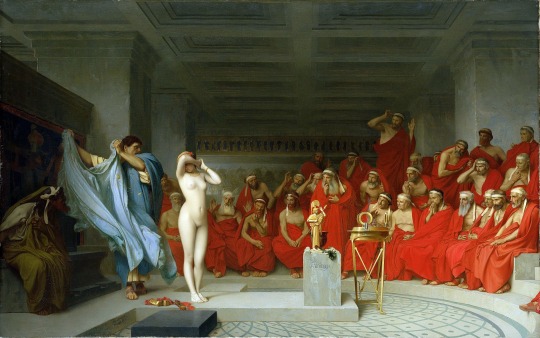
Phryne before the Areopagus
Phryne was acquitted after her defender Hypereides removed her robe and exposed her naked bosom, "to excite the pity of her judges by the sight of her beauty."
1 note
·
View note
Photo

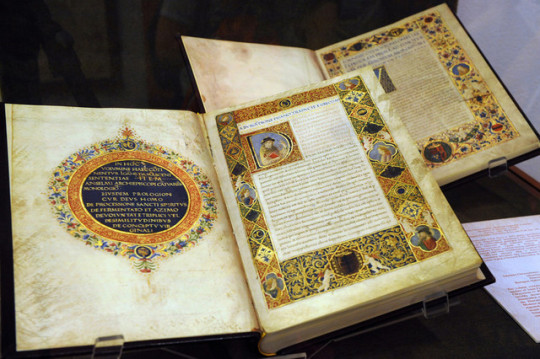


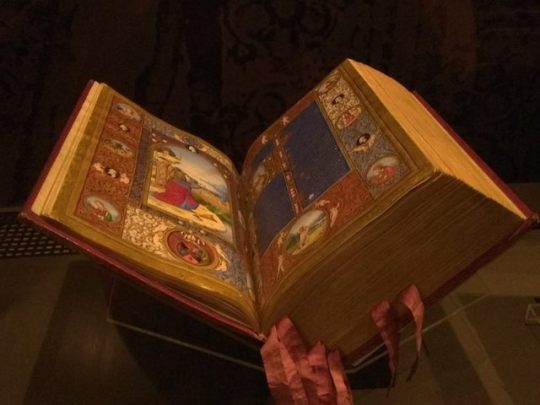




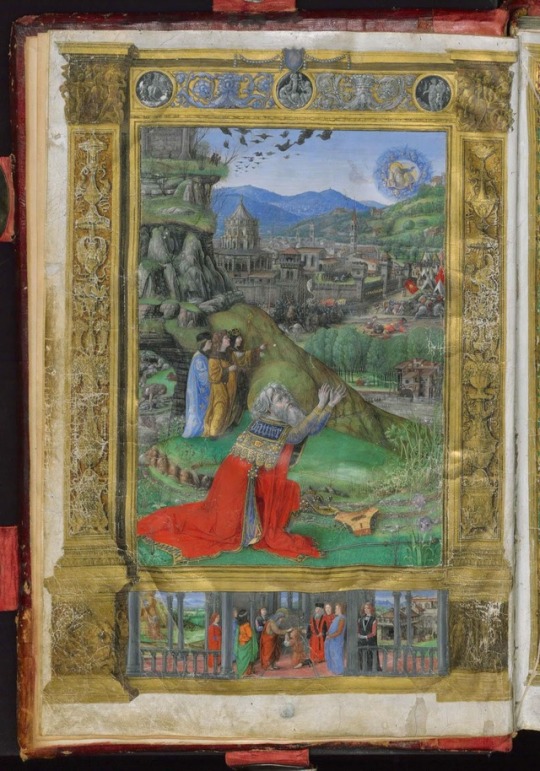
The famous Corvina Library A lot of splendid corvinas and other decorative codices have arrived in National Széchényi Library from various parts of the world, from New York, Paris, the Vatican City, as well as from Hungarian collections. Out of the manuscripts, several precious items, representing an important part of the history of culture, are on display for the first time in Hungary. Corvina Library or Bibliotheca Corviniana was one of the most renowned libraries of the Renaissance world, established by Matthias Corvinus, King of Hungary, in Buda Castle between 1458 and 1490. North of the Alps, Matthias' library was the largest in Europe, and its vast contents was only second to the Vatican Library in the whole of Europe, according to contemporary accounts. It was the greatest collection of science writings in its time. In 1489, Bartolomeo della Fonte of Florence wrote that Lorenzo de Medici founded his own Greek-Latin library encouraged by the example of the Hungarian king. Matthias, one of the most powerful rulers of the age, started to collect the books from about 1460. At the king's death in 1490, the library consisted of about 3,000 codices or "Corvinae" which included about four to five thousand various works, many of classical Greek and Latin authors. It represented the literary production and reflected the state of knowledge and arts of the Renaissance and included works of philosophy, theology, history, law, literature, geography, natural sciences, medicine, architecture, and many others. Nearly two thirds of the surviving volumes had not been printed before the king's death. Some of them contained the sole copy of the works in them, like the book of Constantine Porphyrogennetos on the habits in the court of the Byzantine emperor, or the church history of Nikephoros Kallistos. Some lost Corvinae works are also known, with which the only copy of ancient books perished, including the full works of Hypereides, and writings by Flavius Cresconius Corippus, Cuspinianus and Procopius. Items from the Bibliotheca Corviniana were inscribed on UNESCO’s Memory of the World Register in 2005 in recognition of their historical significance.
4 notes
·
View notes
Text


⌯𝒫𝒽𝓇𝓎𝓃𝑒 𝒷𝑒𝒻𝑜𝓇𝑒 𝓉𝒽𝑒 𝒜𝓇𝑒𝑜𝓅𝒶𝑔𝓊𝓈⌯ by Jean-Léon Gérôme, 1861.
The subject matter is Phryne, a legendary courtesan in ancient Greece who was put on trial for impiety. Phryne was acquitted after her defender Hypereides removed her robe and exposed her naked bosom to the jury.
@rucazombie
1 note
·
View note
Photo

Spectacular!!! Currently wallpaper on my TV screen #ArtAppreciation ♥️🖼🎨 "Fryne na święcie Posejdona w Eleusis" (Phryne at the Festival of Poseidon in Eleusis) (1889) Oil on canvas/ Height: 390 cm (12.7 ft); Width: 763.5 cm (25 ft)/ Collection: Russian Museum. By Henryk Siemiradzki (Polish, 1843–1902) https://en.wikipedia.org/wiki/Henryk_Siemiradzki Polish painter based in Rome, best remembered for his monumental academic art. He was particularly known for his depictions of scenes from the ancient Greek-Roman world and the New Testament, owned by many national galleries of Europe. The painting depicts, Phryne (/ˈfraɪni/; Ancient Greek: Φρύνη) (born c. 371 BC) was an ancient Greek courtesan (hetaira), from the fourth century BC. She is best known for her trial for impiety, where she was defended by the orator Hypereides. Phryne here is shown naked, preparing to step into the sea. https://en.wikipedia.org/wiki/Phryne #ArtAwarness #CelebrateTheArts #Kunstliebhaber #Art https://www.instagram.com/p/CH6WxHVJlnh/?igshid=1vendv53ydngp
0 notes
Photo

Jean-Léon Gérôme [French. 1824–1904]
Phryne revealed before the Areopagus 1861
___
The subject matter is Phryne, a legendary courtesan in ancient Greece who was put on trial for impiety. Phryne was on trial for profaning the Eleusinian Mysteries. Phryne was acquitted after her defender Hypereides removed her robe and exposed her naked bosom to the jury when it appeared the verdict would be unfavourable. The sight of her nude body apparently so moved the judges that they acquitted her. Some authorities claim that this story is a later invention.
#jean leon gerome#1800s#1900s#phryne#phryne revealed before the areopagus#art history#art#classical art#fine art#realism#french art#French painting#french
181 notes
·
View notes
Text

"Phryné before the aerophagus" - (1861) Jéan-Léon GÉRÔME
oil on canvas. academicism
"The subject matter is Phryné, a legendary courtesan in ancient Greece who was put on trial for impiety. Phryné was acquitted after her defender Hypereides removed her robe and exposed her naked bosom to the jury."
'O que significa um belo corpo como o desta Phryné? Isto os animais também tem, talvez até mais do que os homens, mas uma alma como a que existe nos homens pintados por Israels, Millet ou Frère, isto os animais não tem, e a vida não teria sido dada para enriquecer nossos corações, mesmo quando o corpo sofre?"
0 notes
Quote
The best known event in Phryne's life is her trial. Athenaeus writes that she was prosecuted for a capital charge and defended by the orator Hypereides, who was one of her lovers. [...] When it seemed as if the verdict would be unfavourable, Hypereides removed Phryne's robe and bared her breasts before the judges to arouse their pity. Her beauty instilled the judges with a superstitious fear, who could not bring themselves to condemn 'a prophetess and priestess of Aphrodite' to death. They decided to acquit her out of pity.
Phryne - Wikipedia
1 note
·
View note
Text
Blood of Christ
read it on the AO3 at http://ift.tt/2vrusbz
by Hypereides
Words: 511, Chapters: 1/1, Language: 中文
Fandoms: Preacher (TV)
Rating: Explicit
Warnings: No Archive Warnings Apply
Categories: M/M
Characters: Proinsias Cassidy, Jesse Custer
Relationships: Proinsias Cassidy/Jesse Custer
Additional Tags: Blood, Anal Sex, Blasphemy, Religious Imagery & Symbolism
read it on the AO3 at http://ift.tt/2vrusbz
1 note
·
View note
Text
夏日光辉
read it on AO3 at https://ift.tt/2K5BuLf
by Hypereides
至少今夜,一切都有了答案,一切恐惧、嫉妒与痛苦在此刻停止。他知道这就是一切的结局了。我亲爱的,我亲爱的,愿我们永远铭记这夏日光辉。
Words: 5012, Chapters: 1/1, Language: 中文
Fandoms: Men's Football RPF
Rating: Not Rated
Warnings: Creator Chose Not To Use Archive Warnings
Categories: M/M
Characters: Julen Guerrero, Ernesto Valverde
Relationships: Julen Guerrero/Ernesto Valverde
Additional Tags: Athletic de Bilbao
read it on AO3 at https://ift.tt/2K5BuLf
0 notes
Photo

The Big Reveal, a theme revisited by Gerome: 'Phryne before the Areopagus (French: Phryne devant l'Areopage) is an 1861 painting by the French artist Jean-Léon Gérôme. The subject matter is Phryne, a legendary courtesan in ancient Greece who was put on trial for impiety. Phryne was acquitted after her defender Hypereides removed her robe and exposed her naked bosom to the jury.' (From Wikipedia) #jeanleongerome #phrynebeforetheareopagus #phrynedevantlareopage #fineart #artnude #lesrevue https://www.instagram.com/p/BrirKWRH-v1/?utm_source=ig_tumblr_share&igshid=18iqui35h9anc
0 notes